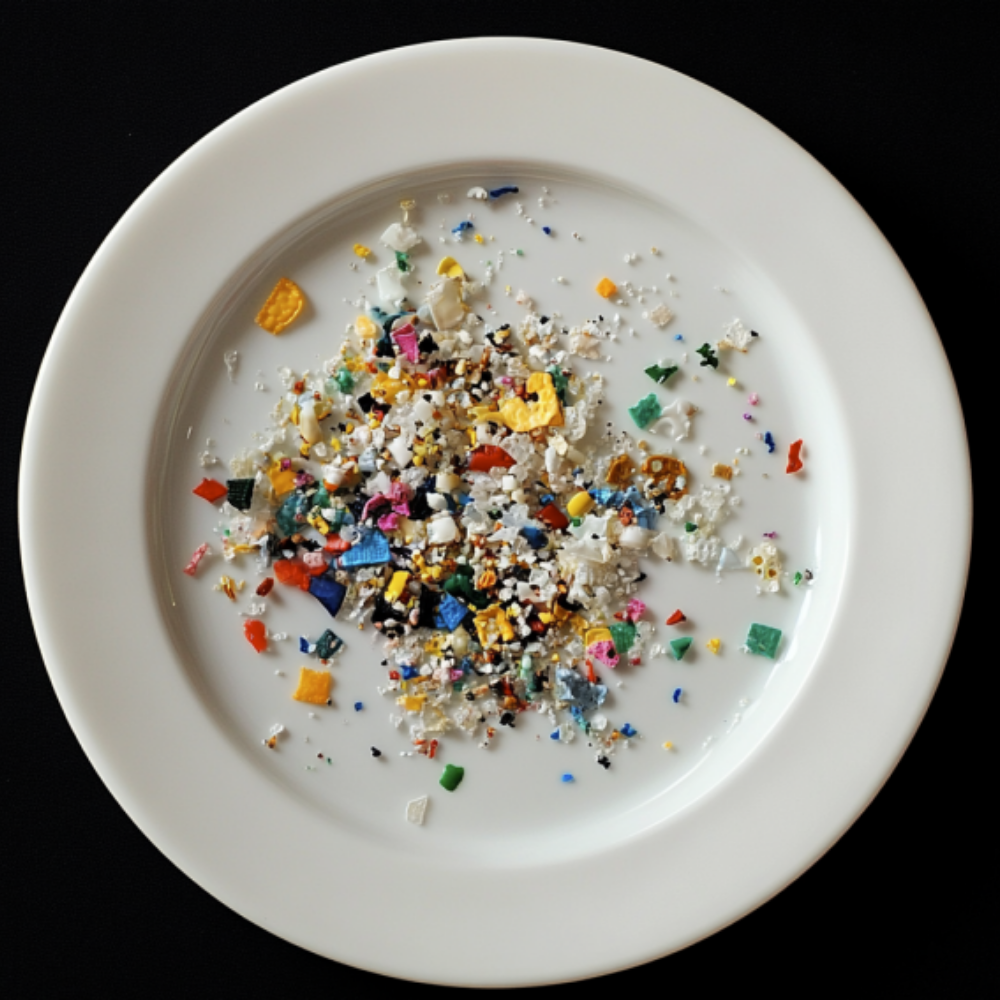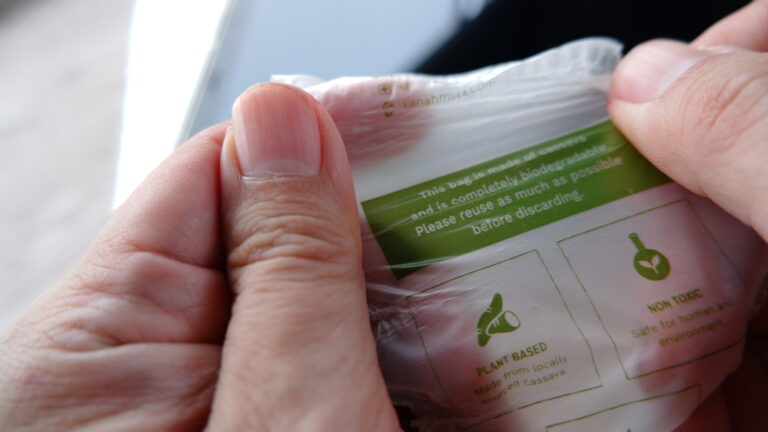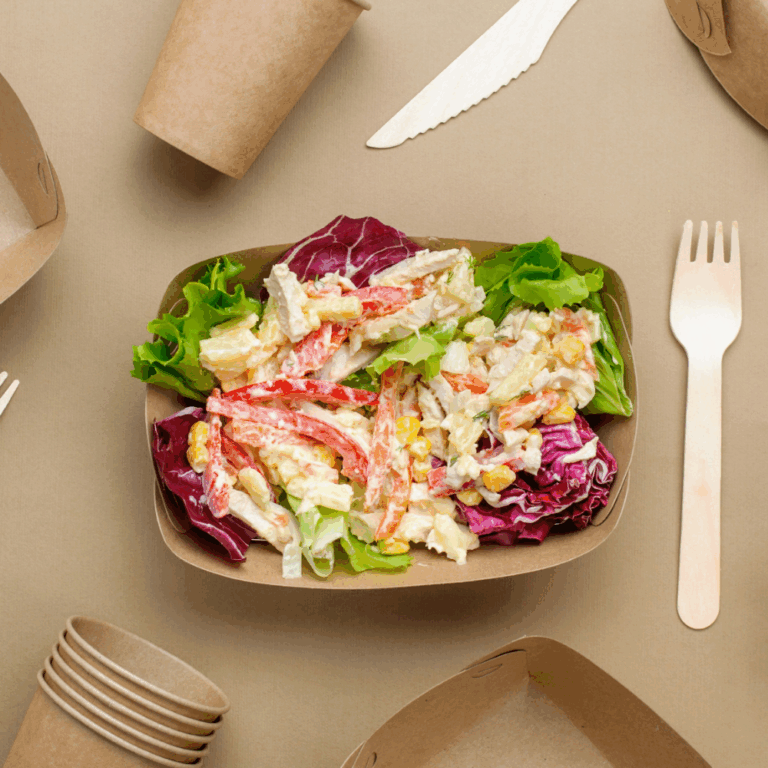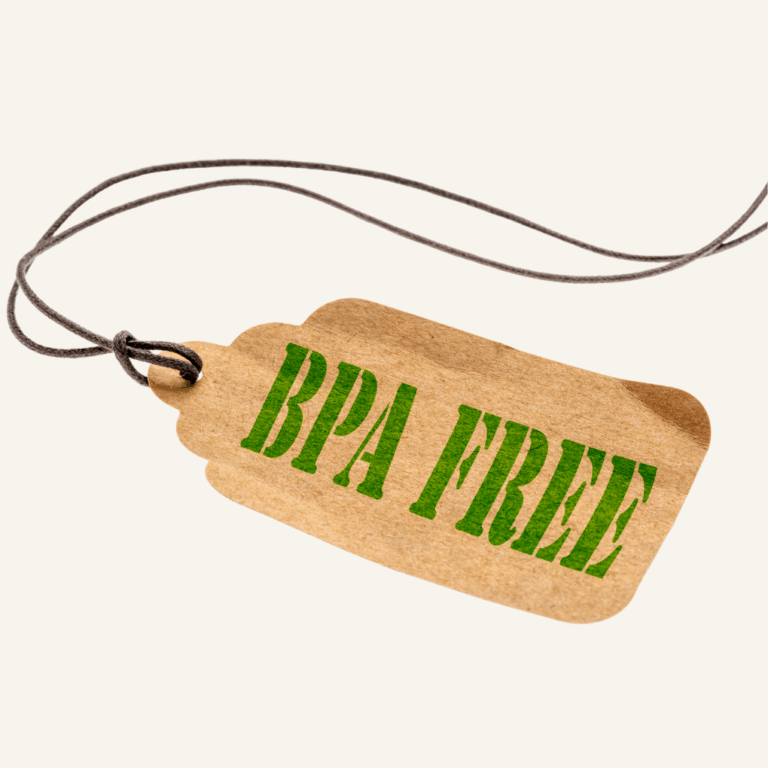
Key Takeaways
- Microplastics are found in everyday foods — from bottled water and seafood to salt and fresh produce — due to plastic pollution and packaging.
- To avoid microplastics in food, choose glass or stainless-steel containers, filter your water, and limit processed and packaged products.
- Eating whole foods, supporting plastic-free brands, and improving kitchen habits can significantly reduce your exposure and protect long-term health.
If the thought of tiny bits of plastic ending up in your food makes you uneasy, you’re not alone. These little pieces, called microplastics, are smaller than a sesame seed, but they’re showing up almost everywhere.
Scientists have discovered microplastics in various food products, including fruits, vegetables, fish, grains, dairy products, salt, and even bottled drinks. That means most of us are eating or drinking small amounts of plastic without realizing it.
No one knows precisely what that means for our health yet, but experts agree it’s a good idea to reduce exposure wherever possible. This guide breaks down what microplastics are, how they get into your food, and — most importantly — how to avoid microplastics in food with simple, everyday choices that keep your meals cleaner and safer.
What Are Microplastics and How Do They Enter Our Food?
Microplastics are tiny plastic particles that form when larger plastic items break down. This pollution can come from everyday plastic waste, including bottles, bags, and packaging materials, which slowly fragment over time due to environmental exposure. Some microplastics are so small they’re invisible to the naked eye, while others are about the size of grains of sand.
Take a plastic bottle, for example. When exposed to sunlight, weather, and friction, the plastic begins to degrade. This process can take hundreds of years, and as it breaks down, the bottle fragments into smaller and smaller pieces. These plastic particles don’t just vanish, they scatter into the environment, eventually making their way into waterways, oceans, and the air.
5 Most Common Sources of Microplastics in Food
I know it’s easy to feel overwhelmed with all the news we hear, especially when it comes to the safety of our food. It’s hard not to feel a sense of dread every time we learn about another potential threat.
But that’s precisely why I’m sharing this, because we all need to start changing our buying habits and focusing on more plastic-free products. The more we choose alternatives, the more we can reduce our exposure to microplastics and help protect our health and the planet.
🥤 Bottled Water and Beverages
Think bottled water is a “clean” choice? Studies have found that bottled water often contains far more microplastics than tap water, thanks to the manufacturing and bottling process. Researchers from Columbia University discovered that a single liter of bottled water can contain an average of 240,000 plastic fragments. Other packaged drinks, like soda or juice, aren’t exempt either; plastic lids, liners, and bottles all contribute to contamination.
🐠 Seafood and Fish Products
Microplastics are infiltrating our oceans and waterways, causing a ripple effect that ends up on our plates. From tiny filter feeders like shellfish to larger fish, marine life often mistake these plastic particles for food. As they consume microplastics, they unknowingly carry them up the food chain, making their way into the seafood we eat.
While seafood is packed with nutrients like heart-healthy omega-3s, it’s worth considering how much plastic you’re swallowing along with your fish.
🍔 Processed Foods and Packaging
Processed foods and their packaging are some of the biggest culprits when it comes to microplastics. Single-use plastic wraps, containers, and even vacuum-sealed packaging are everywhere, especially in convenience foods.
Things like snack packs, frozen meals, and pre-prepared dishes often carry the most plastic residue. The issue is that these plastic particles don’t just stay trapped in the packaging, they can transfer into the food itself as the packaging degrades, making it harder to avoid exposure. So, while those quick and easy meals may be tempting, they could come with a side of microplastics you didn’t ask for.
🧂 Salt and Other Seasonings
A study published in Environmental Science & Technology found that a staggering 90% of table salt brands sampled worldwide contained microplastics. The study analyzed 39 salt brands from 21 countries, and 36 showed signs of microplastic contamination.
It’s pretty wild to think that something as simple as table salt can be contaminated, but unfortunately, it’s true. Sea salt, in particular, often picks up plastic particles because of the pollution in our oceans. But microplastics don’t stop there, other salt types can also be affected. And it’s not just salt! Seasonings stored in plastic containers or processed with additives can also be sources of microplastic contamination in your meals.
A great way to avoid this is by opting for seasonings in glass containers, which help reduce plastic exposure and keep your meals cleaner, both in taste and health.
🥦 Fresh Produce Exposure
Even fresh fruits and vegetables aren’t entirely safe from microplastics. These tiny particles can make their way into agricultural soil in several ways. Microplastics can settle on crops from polluted soil, water sources, or even plastic mulch used in farming. Additionally, when produce is packaged or stored in plastic containers, microplastics can be picked up during transportation and storage.
The journey of microplastics is complex and interconnected. For instance, plastic pollution in the ocean doesn’t just affect marine life, it can also impact salt harvested from seawater. Similarly, plastics in agricultural soil can end up in the crops we eat. This widespread issue spans the entire food system, making it harder to avoid microplastic contamination no matter where our food comes from.
How to Avoid Microplastics in Food
While it’s impossible to eliminate exposure to microplastics in food, there are several effective strategies to reduce your intake significantly. Start by minimizing the use of plastic food containers and instead opt for reusable ones like glass, stainless steel, or ceramic alternatives, especially when storing hot foods or reheating meals. Filter your drinking water using a high-quality water filtration system that removes microplastics and avoids bottled water when possible.
Filtering Your Water
Drinking water, whether from a tap or a bottle, can contain microplastics. Using a good water filtration system, like one with reverse osmosis or a filter designed for microplastics, can help reduce your exposure. To go further, skip bottled water entirely. It’s often stored in single-use plastic, which adds to the problem. Instead, choose reusable glass or stainless-steel bottles and fill them with filtered water.
Choosing Seafood Wisely
Fish and other seafood can accumulate microplastics from polluted oceans, with larger predatory species like tuna or swordfish carrying the highest levels. Choosing smaller fish, such as sardines, anchovies, or mackerel, can help reduce your intake of microplastics.
These smaller species are a more sustainable option and tend to contain fewer pollutants overall. When possible, buy fresh or frozen seafood from sources prioritizing sustainable fishing practices, as they often take steps to minimize environmental contamination.
Don’t Miss: Is Your Seafood Contaminated by Microplastics? Love seafood but worried about what’s hiding in your plate? Discover how microplastics enter fish and what you can do to reduce your exposure. Read more →Packaging Matters
Food packaging plays a more significant role than many realize in microplastic exposure. Foods stored in plastic containers or wraps can absorb microplastic particles over time. When shopping, look for alternatives like glass jars, paper cartons, or cardboard packaging. For example, opt for peanut butter in glass jars or pasta in cardboard boxes. Paying attention to packaging materials is an easy habit to build and makes a big difference over time.
Avoiding Plastic in the Kitchen
The kitchen is often a hotspot for plastic usage, but some adjustments can help reduce exposure. One critical practice is avoiding plastic containers in the microwave, as heat can increase the transfer of microplastics into your food. Similarly, skip single-use plastic wraps for covering leftovers; reusable silicone lids or beeswax wraps are excellent alternatives. By phasing out plastic in your cooking and storage routines, you create a healthier and more sustainable kitchen environment.
Cleaning Your Food Preparation Areas
Proper cleaning techniques in your kitchen can significantly reduce the accumulation of microplastics on food preparation surfaces. These particles can transfer to your meals during cooking and food storage, making kitchen hygiene crucial for avoiding microplastics in food.
Effective Surface Cleaning for Food Safety
Use a damp cloth instead of dry dusting on countertops and food preparation surfaces. This technique traps microplastic particles rather than dispersing them into the air, where they can settle on food. Simple cleaning solutions, such as vinegar and water or baking soda and water, effectively remove particles without introducing additional chemicals.
When cleaning areas where food is prepared, wet mopping is more effective than dry sweeping for removing microplastic particles that may have settled on the floor. Focus on areas around food storage and preparation zones.
Air Quality and Food Preparation
Installing an air purifier with a HEPA filter or S-class filter near your food preparation areas can capture airborne microplastics before they settle on ingredients or cooking surfaces. The EPA’s Safer Choice Program recommends these filtration systems for reducing particulate matter in food preparation environments.
A bagged, sealed-system vacuum is preferable to bagless models when cleaning kitchen areas, as it prevents particles from escaping back into the air near your food storage areas. Robot vacuum cleaners with HEPA filtration can help maintain cleaner floors in dining and kitchen spaces between deep cleaning sessions.
Whole Foods Over Processed
Processed foods often come wrapped in layers of plastic packaging and are more likely to encounter plastic during manufacturing. Shifting your diet toward fresh, whole foods reduces your exposure to microplastics and aligns with broader sustainability and health goals. For example, purchase fresh vegetables and prepare your own instead of buying pre-packaged salad kits. Cooking at home with unprocessed ingredients is a simple yet effective way to minimize plastic-related contamination.
Sustainable Storage Solutions
Fresh produce doesn’t need to live in single-use plastic bags. Opt for reusable produce bags made from natural fibers, such as cotton or hemp, which are both durable and eco-friendly. To take sustainability to the next level, consider growing your herbs, leafy greens, or even small vegetables. By cultivating a portion of your food, you can ensure it’s free from unnecessary plastic exposure and enjoy the added benefits of fresher, tastier ingredients from your garden or windowsill.
Don’t Miss: Sustainable Food Packaging See how small packaging changes can make a big difference. Discover eco-friendly materials and practical swaps that help cut waste in your kitchen. Read more →How to Identify and Choose Foods with Minimal Microplastic Risk
Reading food labels and understanding packaging can significantly reduce your exposure to microplastics. Current food safety standards don’t require companies to test for microplastics, making it essential to know what to look for when shopping.
How to Read Food Packaging Labels to Avoid Microplastics
Look for recycling codes on food packaging to identify the safest options. Packages marked with codes 3, 6, and 7 (PVC, polystyrene, and “other” plastics) pose a higher risk of microplastic contamination in food. Instead, choose foods in glass jars, paper cartons, or aluminum containers when possible.
Foods labeled as “BPA-free” aren’t automatically safe from microplastics, as manufacturers often substitute other plastics that can still break down into particles. The most reliable way to avoid microplastics in food is to choose items with minimal plastic contact throughout the supply chain.
Choose Brands That Use Safer, Plastic-Free Food Packaging
Many food companies are adopting circular economy principles by reducing plastic packaging and improving their supply chain transparency. These businesses often participate in sustainability initiatives and provide detailed information about their packaging materials on websites or product labels.
When you consistently choose brands that minimize plastic use in food packaging, you’re supporting companies that align with emerging food safety standards. This consumer demand encourages more businesses to adopt practices that reduce microplastic contamination in their products.
Shop Local for Fresher Food with Fewer Microplastics
Community workshops and local food cooperatives often focus on connecting consumers with producers who prioritize sustainable packaging. Farmers’ markets, community-supported agriculture (CSA) programs, and local food hubs typically offer fresh produce with minimal exposure to plastic during the growing, harvesting, and distribution processes.
These local food networks often provide transparency about their growing and packaging practices, making it easier to avoid microplastics in your food while supporting regional food systems that prioritize public health measures over convenience packaging.
Stop Microfibres from Reaching Your Food at Home
Synthetic clothing releases microfibres during washing, which can settle on food preparation surfaces and contaminate meals. Choose natural clothing made from organic cotton, hemp, or wool for family members, especially when cooking or eating.
Children face higher risks from microplastic exposure due to their developing systems and increased sensitivity to chemical exposures. Protecting them requires targeted approaches to prevent microplastics from entering the food during these crucial early development stages.
Safe Feeding Equipment and Food Storage
Reducing microplastics at home starts with how we store and prepare food. Plastic containers, wraps, and utensils can shed tiny plastic particles over time — especially when exposed to heat or wear.
Switching to glass or stainless-steel containers is one of the easiest ways to make meals safer. They don’t leach microplastics or chemicals into food, even when reheating. For meal prep, try wooden or bamboo utensils instead of plastic ones, which can release small fragments when scratched or melted.
Good ventilation also helps. Open windows or use an air purifier near cooking areas to prevent airborne microplastics from settling on food. And when packing lunches or storing snacks, skip single-use plastic bags — reusable cloth or silicone pouches work just as well and last longer.
Safer Baby Feeding: Glass Bottles and Plastic-Free Gear
Babies are particularly susceptible to microplastic exposure, so even small changes can make a significant difference at mealtime. When choosing bottles, opt for glass options like Dr. Brown’s Natural Flow Anti-Colic Narrow Glass Baby Bottle. It’s sturdy, easy to clean, and free from plastic particles that can leach into milk or formula.
Replace plastic plates, bowls, and spoons with stainless steel or food-grade silicone. These materials don’t break down into microplastics and are gentle on little mouths. When storing baby food, always use glass jars or stainless-steel containers; they are safer for your child and better for the planet.
A baby’s developing system can’t filter out toxins as well as an adult’s can, which makes prevention especially important during these early years. Simple swaps now can help protect their health for years to come.
Don’t Miss: Best Glass Baby Bottles for a Safer, Plastic-Free Feeding Routine Looking to switch from plastic to glass? Check out the top-rated baby bottles that are durable, easy to clean, and completely microplastic-free. Read more →How to Remove Microplastics from Your Body
While we can’t exactly hit the “undo” button on microplastics once they’ve entered our bodies, you can take steps to help your body flush out these particles and reduce their buildup. Here’s how to give your body a little extra help in the detox department:
💧Hydrate Like It’s Your Job
Water is your best friend when flushing out toxins, including microplastics. Staying hydrated helps your body function at its best, ensuring that your kidneys and liver have what they need to process and eliminate waste. Drink plenty of water throughout the day and add a splash of lemon for an added detox boost.
🥦 Fiber Up for Detox Support
Fiber is a superstar in promoting digestion and helping your body eliminate waste. Foods high in fiber, like fruits, vegetables, whole grains, and legumes, can help push toxins out of your system through regular bowel movements. Aim to include a variety of fiber-rich foods in your meals, like chia seeds, beans, and leafy greens, which can support your body’s natural detox pathways.
🫐 Support Your Liver with Antioxidants
Exercise isn’t just good for your muscles — it’s one of the best ways to help your body release toxins through sweat. Whether you enjoy walking, cycling, dancing, or hot yoga, any activity that gets you moving is beneficial. Regular exercise also supports digestion and metabolism, helping to maintain a healthy balance in the body.
😅 Sweat It Out
Exercise isn’t just great for your muscles, it’s also a fantastic way to help your body eliminate toxins through sweat. Regular physical activity, especially activities that get you sweating (like running, cycling, or even a hot yoga session), can help release toxins, including microplastics, through your skin. It’s also beneficial for maintaining a healthy digestive system and a strong metabolism, which can aid in the overall elimination process.
Beyond the Kitchen: Taking Action Together
We can all make better choices at home, but real change also depends on what happens on a bigger scale. That’s where laws and global policies come in. From banning single-use plastics to redesigning packaging systems, governments and organizations are working to build a safer, cleaner food future for everyone. Understanding these efforts helps you see how your personal habits and your voice can make a difference.
The Global Push to Keep Plastic Off Our Plates
Across the world, countries are collaborating to reduce plastic waste — and it’s starting to transform how our food is grown, packaged, and sold. The United Nations Environment Programme (UNEP) is leading the charge with its Global Plastics Treaty, a landmark agreement being developed by the Intergovernmental Negotiating Committee (INC) to reduce plastic pollution at the source.
This treaty promotes a circular economy, where plastics are reused or replaced with safer, more sustainable materials rather than being discarded. Over time, these changes are expected to enhance food safety standards and reduce the amount of microplastics entering our food supply.
Why Policy Matters for Cleaner, Safer Food
Every country handles microplastic regulations differently, but awareness is growing rapidly. New policies are starting to address plastic use in farming, food packaging, and manufacturing, all key areas where microplastics can enter our food supply.
These laws are designed to protect consumers while helping companies shift to safer alternatives. As more governments adopt stronger standards, it will become easier for all of us to make food choices that are both healthy and low in plastic contamination.
Change Starts Locally
Change doesn’t just happen at the top — it starts in our neighborhoods, too. Local groups, farmers’ markets, and eco-focused businesses are pushing for cleaner, plastic-free practices right where we live.
Joining a community sustainability initiative or supporting brands that reduce plastic packaging can amplify your impact. When enough people speak up and shop with intention, it creates real pressure for policy change, and that’s how safer food systems grow from the ground up.
Learn More About Microplastics: Health Risks and Sources Get the big-picture guide to what microplastics are, where they show up, and practical ways to reduce exposure at home and in your food. Read more →FAQs on How to Avoid Microplastics in Food
Washing fruits and vegetables under running water can help remove surface-level particles, such as dust or plastic fibers, but it won’t eliminate microplastics that have entered the food itself. Cooking doesn’t destroy microplastics, either; they’re made of materials that resist heat. The best way to reduce exposure is to buy unpackaged produce and use reusable produce bags instead of plastic ones.
Not completely. Organic foods are grown without synthetic chemicals, but they can still be exposed to microplastics through soil, air, or water contamination. However, many organic farms use fewer plastic-based fertilizers and mulches, so choosing organic can result in slightly lower overall exposure.
Yes, especially when exposed to heat or scratches. Cooking or stirring with plastic utensils can cause small plastic fragments to break off and become mixed into the food. It’s safer to switch to wooden, bamboo, or stainless-steel tools, which don’t shed microplastics or leach chemicals over time.
This Has Been About How to Avoid Microplastics in Food
While it’s helpful to take steps to support your body’s natural detox processes, the real change begins with reducing your exposure to microplastics in the first place. The more we rely on plastic-free products and make conscious choices in our daily lives, whether it’s choosing fresh, unpackaged foods or investing in eco-friendly storage and cookware, the fewer microplastics we’ll absorb.
It’s time to shift our habits for the sake of our health and the planet’s future. No matter how small, every plastic-free choice makes a difference in the fight against microplastics. Start today, your body and the Earth will thank you for it.
View Article Sources
- Cox, K. D., Covernton, G. A., Davies, H. L., Dower, J. F., Juanes, F., & Dudas, S. E. (2019). Human Consumption of Microplastics. Environmental Science & Technology, 53(12), 7068-7074. Retrieved from Human Consumption of Microplastics | Environmental Science & Technology
- Min, W., & Yan, B. (2024). Microplastic contamination in bottled water. Proceedings of the National Academy of Sciences. Retrieved from Plastic particles in bottled water | National Institutes of Health (NIH)
- Kim, S.-K., & Greenpeace East Asia. (2018). Microplastics in Table Salt from 21 Countries. Environmental Science & Technology. Retrieved from Global Pattern of Microplastics (MPs) in Commercial Food-Grade Salts: Sea Salt as an Indicator of Seawater MP Pollution | Environmental Science & Technology






